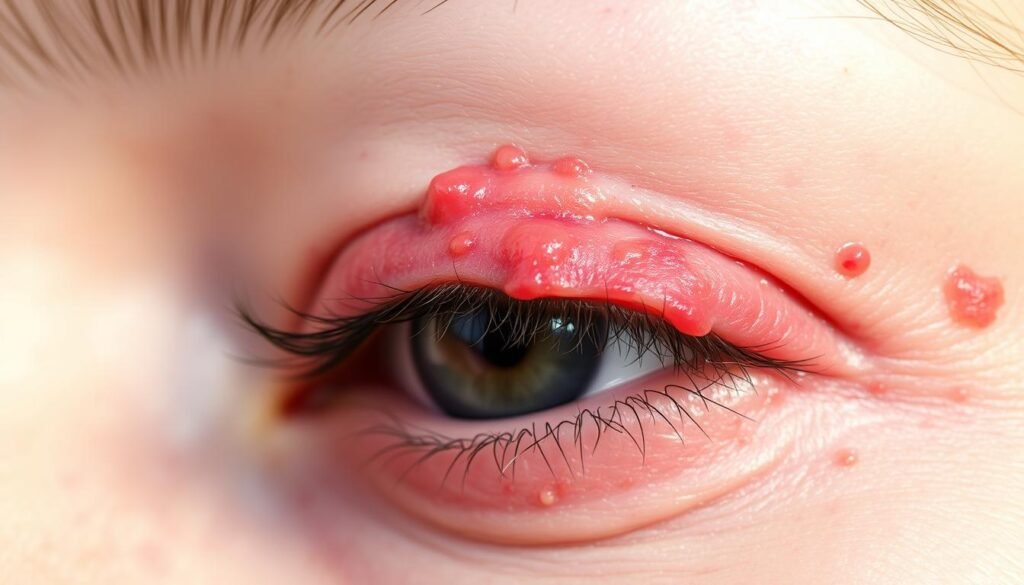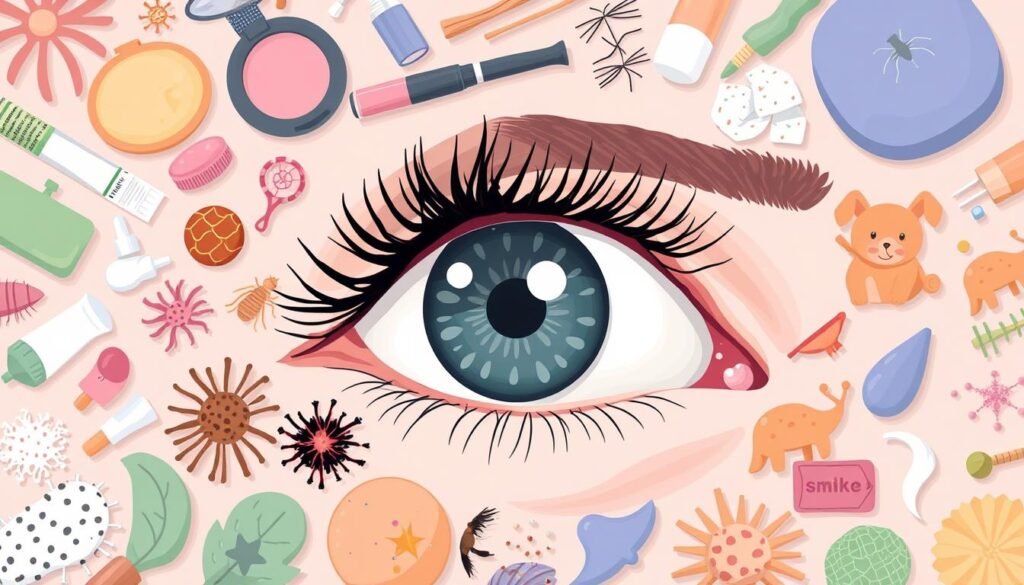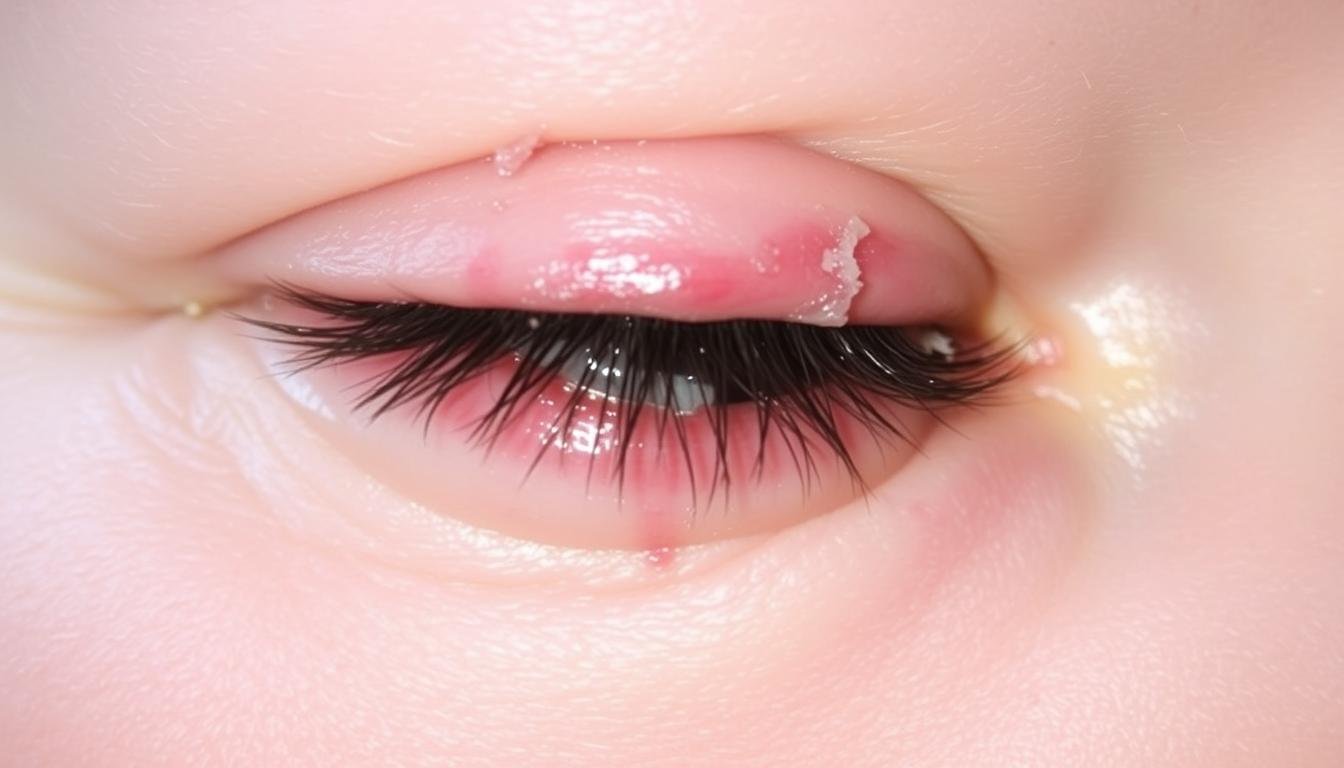Ever wake up with a rash on your eyelid that won’t fade? The itching, redness, and discomfort can be really bothersome. We’re diving into eyelid dermatitis, a common skin issue that affects many people.
A rash on your eyelid can come from many sources, like makeup or the environment. When your eye skin meets an allergen or irritant, it can get inflamed and uncomfortable.
In this guide, we’ll explore the world of eyelid skin problems. We’ll help you understand and tackle these symptoms. By looking into the causes and solutions, we hope to offer relief to those dealing with eyelid irritation.
Key Takeaways
- Eyelid dermatitis is a common skin condition affecting the sensitive eye area
- Multiple factors can trigger a rash on eyelid, including allergies and irritants
- The thin skin around eyes makes them particularily vulnerable to reactions
- Professional diagnosis is key for effective treatment
- Prevention strategies can significantly reduce the risk of eyelid skin issues
What Is Eyelid Dermatitis and Its Impact
Eyelid dermatitis is a skin condition that causes eye irritation and inflammation. It affects people who have trouble with their eye area. This condition makes it hard for them to feel comfortable.
This condition shows up in different ways, making everyday tasks tough. Knowing what to look for helps people find and avoid triggers.
Common Signs and Symptoms
Eyelid inflammation shows up in several ways:
- Persistent redness around the eyelids
- Intense itching and eye irritation
- Swelling and puffiness
- Dry, scaly skin patches
- Potential blistering or crusting
Impact on Daily Life
Eyelid dermatitis can really mess with your daily routine. It can make you feel uncomfortable, affect your work, and even make you feel self-conscious. It can also mess with your sleep.
- Reduced visual comfort
- Decreased productivity
- Social embarrassment
- Sleep disruption
Skin Structure of Eyelids
The eyelid’s skin is exceptionally delicate and sensitive. Its thin skin makes it easy to get irritated by things outside.
“The eyelid skin is among the most sensitive areas of the human body, requiring specialized care and attention.” – Dermatological Research Institute
| Dermatitis Type | Primary Characteristics | Typical Duration |
|---|---|---|
| Contact Dermatitis | Reaction to specific allergens | Days to weeks |
| Atopic Dermatitis | Genetic predisposition | Chronic, recurring |
| Seborrheic Dermatitis | Oily skin inflammation | Intermittent |
Understanding and managing eyelid dermatitis can help people deal with its challenges. This way, they can live their lives more comfortably.
Types of Rash on Eyelid Conditions
Eyelid rashes come in many forms, making them tricky to deal with. Conditions like periorbital eczema and allergic conjunctivitis need to be understood. This helps people tackle their skin issues better.
We’ve found several main types of eyelid rash conditions:
- Contact Dermatitis (Irritant and Allergic)
- Atopic Dermatitis
- Seborrheic Dermatitis
- Periorbital Eczema
Studies show that 85% of people with atopic dermatitis face severe itching every day. Common allergens include:
- Pollen
- Dust mites
- Certain plants
- Cosmetic products
- Personal care items
“Identifying the specific type of eyelid rash is key for effective treatment and long-term care.”
Contact dermatitis often results from everyday product use. Symptoms can vary from mild to severe. Allergic conjunctivitis can also be a problem, adding to the challenge.
With the right diagnosis and knowledge, people can find ways to manage and reduce these uncomfortable eyelid issues.
Contact Dermatitis: A Common Culprit
Contact dermatitis is a big problem for people with eyelid rashes and eye irritation. It happens when the skin around the eyes reacts to certain substances. This reaction can cause discomfort and visible symptoms.
Our research shows two main types of contact dermatitis that affect the eyelids:
Understanding Irritant Contact Dermatitis
Irritant contact dermatitis is the most common, making up 80% to 90% of cases. It happens when harsh substances damage the skin’s barrier. Common causes include:
- Harsh soaps and detergents
- Cleaning chemicals
- Cosmetic products with strong ingredients
- Frequent hand washing
Exploring Allergic Contact Dermatitis
Allergic contact dermatitis makes up 10% to 20% of cases. It’s an immune system reaction to specific allergens. This type develops with repeated exposure, leading to the production of immunoglobulin E (IgE).
| Trigger Category | Prevalence |
|---|---|
| Personal Care Products | 40-60% |
| Environmental Factors | 30% |
| Cosmetic Ingredients | 25-35% |
Environmental Triggers
Many environmental factors can cause eyelid dermatitis, including:
- Pollen and dust
- Seasonal allergens
- Workplace chemicals
- Outdoor pollutants
Knowing your specific triggers is key to managing and preventing eyelid dermatitis symptoms.
If you have ongoing eye irritation, see a dermatologist. They can find specific allergens through patch testing. This test checks around 25 to 30 possible triggers at once.
Atopic Dermatitis and Its Manifestations

Atopic dermatitis, or eczema, affects the skin around our eyes deeply. It’s a chronic condition that impacts 10-20% of kids and 1-3% of adults worldwide. Periorbital eczema, in particular, poses unique challenges for those dealing with eyelid inflammation.
The condition stems from genetic changes that mess with our immune system. This makes our skin’s barrier weak, leading to more sensitivity and inflammation.
“The skin around the eyes is approximately three times thinner than facial skin, making it exceptionally vulnerable to irritation and inflammatory triggers.”
Atopic dermatitis shows several key signs:
- Persistent skin irritation around the eyelids
- Intense itching and redness
- Dry, scaly patches
- Potential for secondary skin infections
Our studies show that people with eyelid inflammation from atopic dermatitis often face recurring flare-ups. These can be set off by many things, like:
- Environmental allergens
- Stress
- Hormonal changes
- Certain fabrics or skincare products
Managing periorbital eczema needs a full plan that tackles both symptoms and the immune system’s issues. Seeing a dermatologist can help create a treatment plan. This plan aims to reduce discomfort and stop inflammation from coming back.
Understanding Seborrheic Dermatitis in Eyelids
Seborrheic dermatitis is a skin condition that can affect the area around our eyes. It’s an inflammatory disorder that can be challenging. It often affects areas with many oil-producing glands.
Our skin’s ecosystem can get disrupted, leading to eyelid infection and swelling. The symptoms can cause discomfort and affect how we look.
Role of Meibomian Glands
Meibomian glands are key to eye health. They are in our eyelids and produce oils that protect and lubricate our eyes. If they don’t work right, it can cause inflammation.
- Produce protective eye surface oils
- Regulate moisture balance
- Prevent possible infections
Fungal Factors and Inflammation
The yeast Malassezia is linked to seborrheic dermatitis. About 90% of people with this condition have this yeast on their skin. It can cause inflammation.
“Understanding the underlying mechanisms is key to managing seborrheic dermatitis effectively.” – Dermatological Research Institute
| Characteristic | Details |
|---|---|
| Prevalence | 3-10 per 100 people |
| Age Group Most Affected | Adults 30-60 years |
| Gender Prevalence | More common in males |
Managing seborrheic dermatitis needs a full approach. This includes good eyelid care, medical treatments, and knowing your risks. Talking to a healthcare professional can help find the best ways to manage this condition.
Blepharitis: When Bacteria Affects Your Eyelids
Blepharitis is a common eyelid infection that can really bother your eyes and daily life. It happens when too much bacteria grows on your eyelids. This causes inflammation and makes your eyes feel uncomfortable.
Learning about blepharitis is key:
- Affects both eyelid edges
- Characterized by persistent inflammation
- Can create chronic eye discomfort
There are two main types of blepharitis:
- Anterior blepharitis: Happens at the front eyelid edge near where your eyelashes grow
- Posterior blepharitis: Affects the inner eyelid area that touches your eyeball
“Blepharitis is sometimes referred to as ‘eye dandruff’ due to its distinctive flaky appearance.”
Common signs of this eyelid infection include:
| Symptom | Description |
|---|---|
| Redness | Persistent inflammation around eyelid margins |
| Irritation | Gritty, burning sensations in eyes |
| Discharge | Watery or sticky eye secretions |
Knowing about blepharitis helps you spot early signs and get the right treatment. While it’s tough, you can manage it with good hygiene and doctor’s advice.
Autoimmune Conditions Affecting Eyelids
Autoimmune diseases can really mess with eyelid health, leading to eyelid inflammation and swelling. These diseases are complex, targeting the delicate eye tissues with immune responses.
Many autoimmune disorders can seriously affect the eyelids. They bring unique symptoms and challenges for doctors to diagnose and treat. Knowing about these conditions helps patients spot warning signs early and get the right medical help.
Sjogren’s Syndrome: Understanding Eye Impacts
Sjogren’s syndrome mainly attacks glands that make moisture, leading to dry eyes and eyelid problems. The main signs include:
- Persistent eye dryness
- Increased risk of eyelid inflammation
- Potential corneal damage
- Reduced tear production
Dermatomyositis: Eyelid Manifestations
This rare autoimmune disease poses unique challenges, mainly for eyelid health. Some interesting facts about it are:
| Demographic | Prevalence Details |
|---|---|
| Gender Distribution | More frequent in females |
| Adult Onset | Late 40s to early 60s |
| Childhood Occurrence | Ages 5-15 |
Lupus and Eyelid Manifestations
Lupus can cause complex eyelid symptoms like inflammation and structural changes. Patients might see intermittent swelling, color changes, and sensitivity around the eyes.
“Autoimmune conditions require a detailed, personalized medical plan to manage eye-related symptoms.”
Dealing with these conditions needs specialized medical care. It focuses on overall treatment and specific actions to reduce eyelid inflammation and protect eye health.
Identifying Triggers and Allergens

It’s important to find out what causes eye irritation and eyelid itching. We look at many possible triggers to understand the problem better.
Keeping a symptom diary is very helpful. It helps us find out what might be causing the problem. We suggest tracking:
- Daily environmental exposure
- Personal care products used
- Food and drink consumption
- Stress levels and sleep patterns
- Specific instances of eye irritation
Patch testing can also show hidden allergens. Studies show that about 70% of people with eyelid eczema find a trigger through testing.
| Potential Allergen Category | Common Sources | Prevalence |
|---|---|---|
| Cosmetic Products | Eye creams, makeup | 35% |
| Environmental Triggers | Pollen, dust mites | 25% |
| Skincare Products | Cleansers, moisturizers | 20% |
| Household Items | Detergents, fabrics | 15% |
| Medications | Topical treatments | 5% |
*”Knowledge is the first step in managing eye allergies. Understanding your unique triggers can dramatically improve your quality of life.”*
Eye irritation is often caused by many things working together. By finding and avoiding these triggers, you can manage eyelid itching better. Working with healthcare professionals helps create a plan to reduce itching.
Professional Diagnosis and Testing Methods
When you have eyelid dermatitis or a rash that won’t go away, seeing a doctor is key. Our skin is very sensitive. Doctors need to check it carefully to find out what’s causing the problem and how to fix it.
Dermatologists and allergists use special tests to figure out what’s wrong with your eyelid skin. These tests help find out what’s causing the problem. Then, they can create a treatment plan just for you.
Patch Testing Procedures
Patch testing is the best way to find out if something you touch causes an allergic reaction on your eyelid. Here’s how it works:
- They put different things on your skin to see if you react to them.
- They watch your skin for a few days to see how it reacts.
- They check if your skin has a delayed reaction to something.
“The patch test is the only reliable method for determining substances causing allergic skin reactions.” – Dermatology Research Institute
Getting tested usually takes three visits in one week. They put special panels on your skin for a couple of days. This helps them find out what’s causing the problem.
| Diagnostic Method | Duration | Key Characteristics |
|---|---|---|
| Patch Testing | 3 visits/week | Identifies contact allergens |
| Skin Biopsy | 3-7 days analysis | Detailed tissue examination |
When to See a Specialist
If you have a rash on your eyelid that lasts more than two weeks, you should see a dermatologist. Also, if you have:
- Severe inflammation or pain
- Recurring eyelid dermatitis symptoms
- Suspected allergic reactions
Doctors can give you a detailed diagnosis and a treatment plan that fits your needs.
Medical Treatment Options
Managing eyelid infection and inflammation needs a detailed medical plan. Our experts suggest several strategies to tackle these eye issues effectively.
Medical professionals often recommend these treatments for eyelid problems:
- Topical corticosteroids for reducing inflammation
- Immunomodulator medications
- Antibiotics for bacterial infections
- Specialized eye drops
Studies show that treatment success depends on the condition. For example, topical corticosteroids work for 60-70% of people with moderate to severe eyelid dermatitis.
*Careful medication selection is key to avoid side effects and ensure success.*
Here are some specific treatment options to consider:
| Treatment Type | Effectiveness | Typical Use |
|---|---|---|
| Topical Corticosteroids | 60-70% response rate | Reducing inflammation |
| Dupixent (Biologic) | 75% severity reduction | Moderate-to-severe eczema |
| Antihistamine Eye Drops | 50-60% symptom relief | Allergy-related symptoms |
When choosing treatments, look for products that are “fragrance and dye free.” Also, consider those approved by the National Eczema Association. Always talk to a healthcare provider to create a treatment plan that fits your needs.
Natural and Home Remedies
Dealing with eyelid itching and eye irritation can be tough. But, there are natural ways to find relief. We’ll look at home remedies that can ease discomfort and reduce swelling without harsh treatments.
We recommend gentle, focused treatments that tackle the root of eyelid discomfort. Many people find relief with easy, accessible solutions that lessen eye irritation.
Cold Compress Applications
A cold compress is great for reducing eyelid swelling. Experts say to use a cold for a few minutes to lessen swelling and ease eye irritation.
- Use a clean, soft cloth wrapped around ice pack
- Apply for 5-10 minutes at a time
- Avoid direct contact with skin
- Repeat 2-3 times daily as needed
Gentle Cleansing Techniques
Keeping your eyelids clean is key to managing itching. We recommend a gentle cleaning method to avoid more irritation:
| Cleaning Solution | Technique | Frequency |
|---|---|---|
| 50/50 Baby Shampoo Mix | Gentle Dabbing | 1-2 Times Daily |
| Warm Water | Soft Patting | As Needed |
Important: Always use a clean cotton swab for each eyelid to prevent bacterial spread.
“Gentle care is the key to managing eyelid irritation effectively.” – Dermatology Insights
While these home remedies can help a lot, if symptoms don’t go away, see a doctor. Our focus is on preventive care and taking good care of your eyes.
Prevention Strategies and Lifestyle Changes
To prevent eyelid dermatitis, we need to take care of our skin and lifestyle. Our skin, around the eyes, is very sensitive. It can easily get swollen and irritated. Knowing how to prevent it can keep our eyelids healthy and avoid future problems.
Here are some important lifestyle changes to help prevent eyelid dermatitis:
- Maintain strict makeup hygiene by replacing cosmetics every 3-6 months
- Choose hypoallergenic and fragrance-free products
- Avoid touching or rubbing your eyes frequently
- Use gentle, non-irritating cleansing routines
Our environment also affects our eyelid health. Using a humidifier helps keep our skin moist, which is important in dry weather. It’s best to use cold or lukewarm water for cleaning, as hot water can dry out our skin.
| Prevention Strategy | Benefit |
|---|---|
| Hypoallergenic Products | Reduces irritation risk |
| Regular Makeup Replacement | Prevents bacterial growth |
| Humidifier Usage | Maintains skin moisture |
Protecting your eyelids is about proactive care and mindful product selection.
What we eat also matters for our eyelid health. Eating foods rich in omega-3, staying hydrated, and managing stress are good ideas. Remember, it’s easier to prevent eyelid dermatitis than to treat it.
Understanding Location-Specific Eye Care in Florida
Florida has its own set of challenges for people with rash on eyelid and eyelid inflammation. The state’s unique environment means we need special eye care. It’s important for residents to know about these needs.
The high humidity and strong sun in Florida can make eye skin more sensitive. Our eye care experts in Florida are ready to help. They offer solutions for eye skin problems.
- Orlando: Advanced dermatological eye care centers
- Clermont: Specialized allergy and inflammation treatment
- The Villages: Complete senior eye health services
- Kissimmee: Eye care for all cultures
- Ocala: The latest in eye diagnosis
If you have ongoing eyelid inflammation, our local approach might help. Our team knows how Florida’s weather affects our eyes.
“In Florida, eye care isn’t just about vision—it’s about understanding our unique climate’s impact on skin health.” – Florida Eye Care Association
Florida Eye Care Statistics
| Region | Eye Care Specialty | Population Served |
|---|---|---|
| Orlando | Dermatological Eye Care | 1.3 Million |
| The Villages | Senior Eye Health | 125,000 |
| Kissimmee | Multicultural Services | 280,000 |
We help Floridians take care of their eyes by understanding local needs. This way, we can tackle rash on eyelid issues with the right local knowledge.
Conclusion
Understanding eyelid dermatitis and eye irritation is key. We must pay close attention to what triggers these issues and their symptoms. Our deep dive shows that contact dermatitis is the top cause, affecting 46% to 74% of people with skin reactions near their eyes.
To manage eyelid dermatitis well, we need to spot early signs and find out what might be causing the problem. Getting help from a doctor is also vital. Using the right treatments and making lifestyle changes can help a lot. Our findings stress the need for treatments that fit each person’s needs.
If you’re dealing with eye irritation or skin issues, see a dermatologist. You can call our team at +1(352) 565-7575 for help. They can give you a detailed check-up and a treatment plan that’s just right for you.
Being informed and taking action on eyelid health is important. It helps manage dermatitis, avoids serious problems, and keeps your eyes comfortable and looking good. Early action and the right treatment are essential for dealing with skin issues around the eyes.



